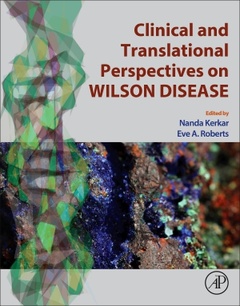Clinical and Translational Perspectives on WILSON DISEASE
Coordonnateurs : Kerkar Nanda, Roberts Eve A

Clinical and Translational Perspectives on Wilson Disease brings together the genetics, cell and structural biology of Wilson Disease into one contemporary, easy to navigate handbook. Created to meet the diverse needs of the clinical and research communities surrounding Wilson Disease, this reference provides a worldwide approach that is concise and translational. Specifically, it provides a basis for clinicians to appreciate ?basic science? aspects of Wilson disease, presenting a guide for researchers to understand the clinical disorder on which their research is focused and fostering constructive dialogue and progress for this puzzling disorder.
1. Introduction 2. History
Cellular physiology 3. Biological aspects of copper 4. Cu uptake (CTR1 etc) 5. Wilson ATPase structure 6. Wilson ATPase function 7. COMMD1 8. Cu in mitochondria 9. Ceruloplasmin 10. Metalloproteomics 11. Cu disposition in bacteria 12. Cu disposition in yeast 13. Animal models—KO mouse
ATP7B gene 14. Characteristics of gene; genetic diagnosis 15. Epigenetics
Clinical aspects 16. WD in adults 17. WD in children 18. Neuro-WD 19. Psychiatric-WD 20. Ophthalmological-WD 21. Biochemical diagnosis 22. Direct determination of NCB-Cu 23. Histopathology 24. Imaging--CNS 25. Role of scoring systems 26. Screening (population; kindreds) 27. Genetic counselling
WD around the world 28. Regional WD: northern Europe 29. Regional WD: Sardinia/ Mediterranean Europe 30. Regional WD: Israel 31. Regional WD: Brazil 32. Regional WD: India 33. Regional WD: China
Treatment 34. Treatment: D-penicillamine 35. Treatment: trientine 36. Treatment: zinc 37. Adherence to medications 38. Liver transplantation 39. New treatment modalities
Special issues related to Wilson disease 40. Wilsonian fulminant hepatic failure 41. Pregnancy 42. WD-mimics 43. ATP7B and Alzheimer disease
Related issues of copper disposition and disease 44. ATP7A disorders 45. Other disorders of copper-handling
Clinical and basic scientists with a research interest in Wilson Disease; Clinicians including Gastroenterologists & Hepatologists.
Eve Roberts trained with Professor Dame Sheila Sherlock at the Royal Free Hospital in London, United Kingdom, and became a pediatric hepatologist and researcher at the Hospital for Sick Children in Toronto. She was the clinician on the team which identified the gene abnormal in Wilson disease and she later collaborated to develop metalloproteomics as a research strategy for Wilson disease. She has written extensively on Wilson disease and pediatric hepatology. Previously full professor and senior scientist, she is currently an adjunct professor of Paediatrics, Medicine and Pharmacology & Toxicology at the University of Toronto, and an adjunct scientist in the Genetics and Genomic Medicine program of the Hospital for Sick Children Research Institute. Additionally, she is an Associate Fellow in the History of Science and Technology Programme at the University of King’s College in Halifax, Nova Scotia.
- Delivers numerous, succinct, expert chapters with summaries designed for quick reference
- Includes a 'How-to appendix' for diagnosis and management tips
- Contains access to a companion website with a self-help teaching module, links to key resources, and an extended reference list
Date de parution : 09-2018
Ouvrage de 502 p.
21.4x27.6 cm
Thèmes de Clinical and Translational Perspectives on WILSON DISEASE :
Mots-clés :
123J-Beta-CIT-SPECT; 123J-IBZM-SPECT; 18FFDG-PET; A domain; APT7B; ATP7A; ATP7A-related copper transport diseases; ATP7B; ATP7B gene; ATP7B mutations; ATP7B structure; ATPase; Aceruloplasminemia; Acute liver failure; Adherence; Adolescent; Adult-onset peripheral motor neuron disease; Adverse event; Advocacy; Alzheimer's disease; Bacteria; Bile; Biomarker; Biotechnology; Brain; Brain iron accumulation syndromes; Cell transplant; Central Europe; Ceruloplasmin; Chelators; Child; China; Chronic cholestasis; Cirrhosis; Clinical; Cognition; Compliance; Congenital glycosylation disorders; Consanguinity; Copper; Copper chaperones; Copper chelator; Copper histidine; Copper homeostasis; Copper toxicity; Copper toxicosis; Copper transporter; Corneal subbasal nerve plexus; Cupruria; Cytochrome c oxidase; D-Penicillamine; D-penicillamine; DNA; Dementia; Depression; Diagnosis; Diagnostic; Diagnostic score; Dimercaprol; Dystonia; Eastern Europe; Egypt; Encephalopathy; End-stage liver disease; Endemic Tyrolean infantile cirrhosis; Endosome; Environment; Epidemiology; Epigenetics; Exchangeable copper; Exogenous copper intoxication; Experimental therapy; Fatty liver; Ferroxidase; Fetal complications; GAS for WD; Gastritis; Gel electrophoresis; Gene; Gene therapy; Genetic counseling; Genetic disorders; Genetic identity; Genetics; Han Chinese; Hepatic parenchymal copper concentration; Hepatocyte polarity; Hepatolenticular degeneration; High-risk pregnancy; Histopathology; History; Homeostasis; Human exposure; Huppke-Brendel syndrome; Idiopathic copper toxicosis; Immobilized metal affinity chromatography; Immuno-SRM; India; Indian childhood cirrhosis; Infant
Ces ouvrages sont susceptibles de vous intéresser

Translational Inflammation 145,45 €


